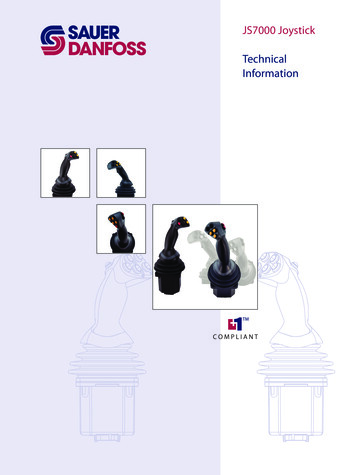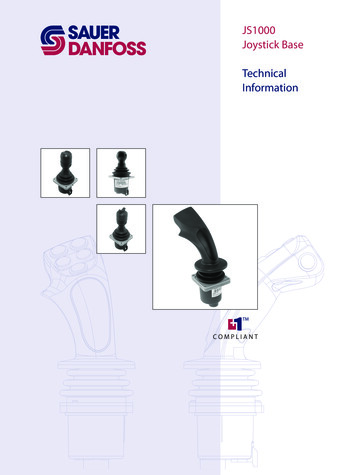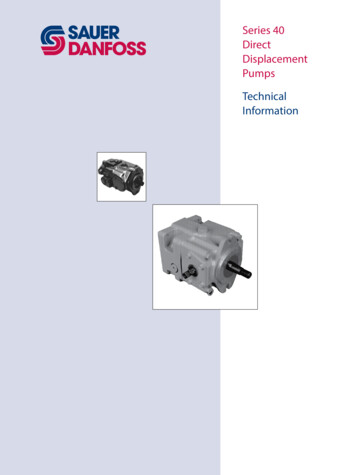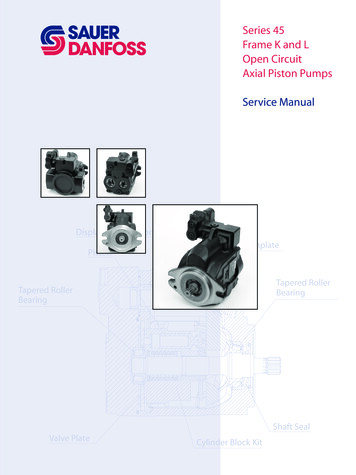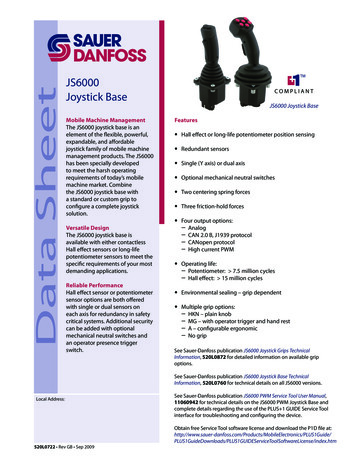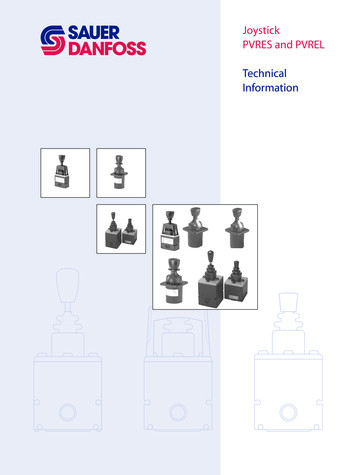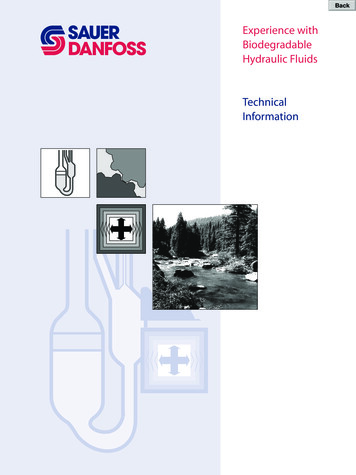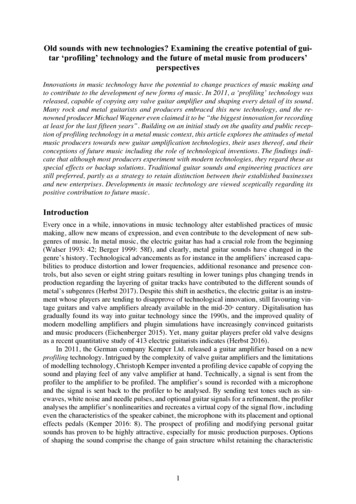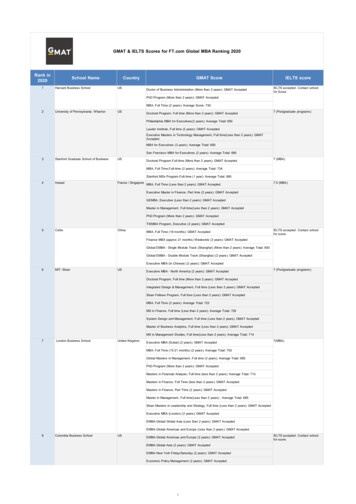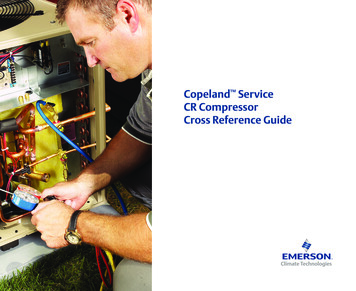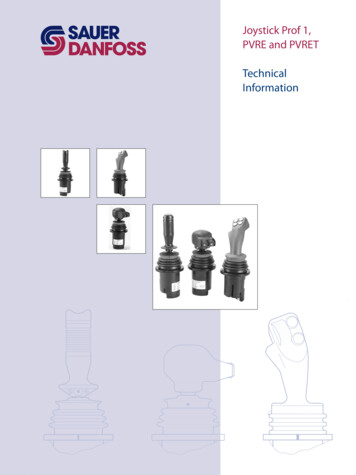
Transcription
MAKING MODERN LIVING POSSIBLEDistrict heating application handbookMaking applications future proofall our knowledge – is now yours 30 yearsof experiencein district heating applications, with more than5 million installations worldwide.districtenergy.danfoss.com
IndexDistrict heating application handbookIntroduction to the handbook.3468910District heating from the insideMatching district heating to building needsHow to read this bookApplication benchmarkingDistrict heating application types – overviewGeneral principles.1314161821Hydronic balancing – control typesHydronic balancing – control functionsIdling functionsWeather compensationRecommended applications. 232735435363717985891. Domestic hot water applications2. Indirectly and directly connected room heating applications3. Supply systems to flat stations applications4. Directly and indirectly connected room heating and instantaneousdomestic hot water heat exchanger applications5. Directly and indirectly connected room heating and domestichot water charging tank applications6. Directly and indirectly connected room heating and domestichot water cylinder applications7. Two-step applications8. Indirectly connected room heating and secondary side connecteddomestic hot water charging tank application S.1.29. Indirectly connected room heating and secondary side connecteddomestic hot water cylinder application S.1.3About Danfoss District Energy.92Appendix. 96989899AbbreviationsApplication symbolsReference list
Page 3 - 11Introduction to the handbook District heating from the inside The relevance of district heating Matching district heating to building needs
4113 millionDistrict heatingfrom the insidemetric tons of CO2 are saved per yearin Europe through district heating supplying9-10% of the heat demand. This corresponds toBelgium’s total annual CO2 emmissions.For more than 35 years, Danfosshas been taking an active roleworking in close cooperationwith customers to offer the rightsolutions for district heatingsystems.No matter the project size, nomatter the specification, Danfosscomponents and substations excelthroughout the world.This is the platform for sharingexperience, application expertiseand making recommendations onoptimum performing district heatingapplications and key applied controlcomponents.ApplicationknowledgeDanfoss recommendationsBackground for this bookVersion 1.0Year 20121st editionEditorial Office:Danfoss A/S – District EnergyNordborgvej 81DK-6430 istrict Energy – Application Centre:Jan Eric Thorsen, ManagerPhone: 45 7488 4494E-mail: jet@danfoss.comOddgeir Gudmundsson, ApplicationSpecialist, Phone: 45 7488 2527,E-mail: og@danfoss.comDanfoss District Energy is the leadingsupplier of products, systems and services for district heating and cooling(DHC), with decades of experience inthe industry.In this way, Danfoss provides customers worldwide with expertise andknowledge that bring truly energyefficient solutions to life.
5IntroductionGreen districtDistrict heatingDistrict heating and cooling networks provide an ideal fit in the heart of a greencity or district. In dense urban environments where heat demand is inevitablyhighest, they are the ideal means of exploiting locally available streams ofrenewable energy and surplus heat supply for a useful purpose. Such systemsgenerate significant, provable reductions of primary energy consumption, cutCO2 emissions and provide citizens with the standard of comfort and reliabilitythey expect.Network conditions and system designDistrict heating networks differ in size, layout and conditions in cities and urbanareas around the world. To achieve the ideal level of performance and usercomfort, temperature settings, operating pressure level as well as technicalbuilding connection requirements need to be appropriate to ensure reliablesupply and operational safety.Influencing trends in district heatingToday, the heating sector is influenced by multiple trends. These are driven byincreased user expectations of comfort and supply security, product design andusability as well as energy-efficient performance prescribed by legislation. Thishas led to district heating application design needing to offer: Reduced temperature and pressure levels in DH networks Energy-efficient operation with higher levels of control performance Monitoring of energy performance and billing according to individualconsumption Secure and safe heat supplyDistrict heating from 1G to 4GDevelopment1G2GSteam system, steam pipesin concrete ductsTemperaturelevel200 o C3GPressurised hotwater systemHeavy equipmentLarge ”build on site” stations4GPre-insulated pipesIndustrialized compactsubstations (also with insulation)Metering and monitoringLow energy demandsSmart grid (optimuminteraction of energysources, distributionand consumption)2-way DH 100 o C 100 o C 50-60 o CEnergyefficiencyOilBiomassSolarIndustry surplusGeothermalCHP coalWaste incinerationWind surpluselectricityCHP gasCHP coalCHP biomassGasCHP gasIndustry surplusPeak oilGasCHPwasteincinerationLocaldistrict ictheatingCHPbiogasDecentralizedheat pumpDistrictheatingDistrictheatingTime (District heating generations)1G2G3G4G
6District heatingMatching district heating System infrastructure andavailable heat sourcesWhere available, district heating is the best heat source you can choose.District heating is good for you financially and good for society as a whole.Where district heating is not available, try to make the best use of the availablealternatives, especially renewable energy. The best solution is always when yousucceed in matching the system infrastructure and design with the availablesupply of energy sources, building type and your customers’ specific needs.12
27District heating to building needsExamples of how controlsoptimize heat systems1. Adjusting to outside temperaturesWhen flow temperature in the heating system reflects outside temperature, theuser will enjoy both increased comfort and lower heating bills. In one-familyhomes, the expected energy saving from weather compensation is 10% onaverage and can be as high as 40%.32. Using available energy sourcesWhether a building uses single or multiple heat sources, correct controlmechanisms ensure optimum output and match supply to the actual needs ofthe building. In this way, comfort is kept high and energy consumption low.3. Balance savings and comfortA properly hydronic-balanced heating system supplies the correct heatingcapacity to all rooms, regardless of load conditions. Energy is saved becausetemperatures match the need in every part of the heating system.
8How to read this bookA comprehensiveoverviewWhen connecting a building to district heating, different options are availablefor heating and preparation of domestic hot water.The aim of this handbook is to give a comprehensive overview ofdifferent applications with a special focus on applications recommendedby Danfoss.All applications are illustrated and described, including how they work and whatoptions are available.For the recommended applications, you will find key benefits and limitations,benchmarking, comparison of different applications and documented values.All applications are prioritized using the following symbols:Danfoss-recommended applicationPrimary alternative to Danfoss-recommended applicationSecondary alternative to Danfoss-recommended applicationPrinciple and purpose ofapplication benchmarkingQualitative as well as quantitativemeasures are included, supportingthe understanding of the benefitsand limitations on the variousapplications.The intention is not to give productspecific information or detailedtheory behind the components orapplications.For product-specific information, werefer to data sheets belonging to theproduct groups. For detailed theory,we refer to technical papers andrelevant scientific material in general.
Application benchmarkingBenchmark parameterInvestment cost savingDescriptionCost of purchasing the heating system and the necessary componentsReduced design and planning time for consultants/designersInstallation time savingTime needed for installing and commissioning the heating systemWeight of the installationSystem complexitySpace requirement savingsAbility to free-up space in the building that can then be used for other purposesMore compact heating system installationCompliance with DHW legislation (3 liter) – only currently in GermanyLow DHW system volume limits legionella growthService/maintenancesavingsInstantaneous DHW preparation limits legionella growth compared to DHW circulationSimplicity and robustness of systemReduced number and duration of service visits will lead to lower service/maintenance costsLower temperature, pressure level and heat loss in the DH network and in the heating systemHeat transfer effectiveness of heating system (HEX)Lower return temperature back to the station and networkWeather compensation of the heating systemEnergy-efficiencyperformanceHighly efficient heating systemEnergy-saving potentialSecondary temperature adapted/optimized to the building heat loadLower hydronic load to a group of customers due to HEX solution (less heat loss and pump energy)DHW quality, avoid bacteria growth – no storage of hot water by instantaneous production ofDHW, compliance with DHW legislation (3 liter) – only currently in GermanySystem operation safetyRisk of leakage and contamination of DH water supplyRisk of exposure to high temperatures (e.g. radiator surface)Unlimited amount of DHWOptimum room temperatur levelUser comfortIndoor climateLength of maintenance cycle (if maintenance cycle is long, there is long time between supply stops)System noiseWaiting time for hot water9
10District heating application typesApplication type overview1Domestic hot waterapplications23Directly and indirectlyconnected roomheating applications4Supply systemsto flat stations1.F1.00.11.05Directly and indirectlyconnected roomheating and instantaneous domestic hotwater heat exchangerapplications1.F1.1Directly and indirectlyconnected roomheating and domestichot water chargingtank 12.23.F3.03.F3.1When connecting a building to DH, many options are available forheating the building and for the preparation of domestic hot water. Inthis handbook, a numbering system is used for different applicationsthat relate to the numbering of their basic components, type of HE andDHW applications e.g. application 1.1 Directly connected HEand instantaneous DHW, which is a combination of applications1.0 Directly connected HE and 0.1 Instantaneous DHW.3.13.23.2
11District heating application types67Directly and indirectlyconnected roomheating and domestichot water .1S.1.2S.1.22.32.33.33.39Indirectly connectedroom heating andsecondary sideconnected domestic hotwater charging tankapplicationIndirectly connectedroom heating andsecondary sideconnected domestichot water ded applicationPrimary alternative to Danfoss-recommended applicationSecondary alternative to Danfoss-recommended applicationNot recommended by DanfossApplication 0.1 Application 1.0 Application 1.11.01.10.1
Page 93 - 95About Danfoss District Energy93
94About Danfoss District EnergyWe mind your businessDanfoss is more than a householdname in heating. Driven by ourcustomers’ needs, we build on yearsof experience to be at the forefrontof innovation, continually supplyingboth expertise, components andcomplete systems for district heatingand cooling applications.As the leading total supplier, Danfossprovides customers worldwide with acomplete range of automatic controls,heat exchangers, domestic hot watersystems and substations, which areapplied throughout the process ofgenerating, distributing and controlling heat to homes and buildings.The products contribute to individualcomfort and reduce energyconsumption as well as providingreliable and lasting operations andguaranteeing minimum servicing.Build on site – componentsWhether you are building heat transferdistrict heating stations or involved inthe design of the heating system application, Danfoss can offer componentsand inherent knowledge that enablesyou to optimize the total solution andcope with current and future demands.Keep your focus on performanceUsing top-performing Danfosscontrols and components forconstructing your heating systemallows you to focus on enhancing totalsystem performance, and therebycreating superior solutions for you andyour customers.For more information, please visit our website districtenergy.danfoss.comA complete product range:» Electronic controllers» Motorized control valves» Self-acting pressure, flow andtemperature controllers» Ball valves» Energy meters» Plate heat exchangers
95About Danfoss District Energy– and your applicationsDoing business with Danfossmeans gaining access to industryleading:» Product portfolio for districtheating and cooling» Consultancy and customerdedication» Innovation, technical optimiza-tion and performance» Safety and reliability incooperation» Global reach with strong localrepresentation and knowledgeDanfoss is therefore a soundchoice whenever district heatingand cooling systems are to beplanned, installed and upgraded.Build to site – predefined applicationsAre you looking for new heat transfertechnology and higher energy efficiency?Do you want to optimize the use andappearance of your heating room? Do youwant high-performance and more time foryour regular activities?Danfoss enables you to deliver completedistrict heating substations that are optimized for high heat transfer performancewith state-of-the-art control components.Danfoss substations can be rapidlydesigned, configured and manufactured.They are tested before delivery to ensurestraightforward installation and a perfectfit in building services systems.This enables you and your customers towork smarter, save time and money, andreduce the amount of space occupied byyour heating system.A complete product range:» Fitted substations(15kW – 300 MW)» Welded substations andmixing loops (15kW – 40 MW)» Domestic hot water systems
We mind your businessdistrictenergy.danfoss.comE-mail: districtenergy@danfoss.com · www.districtenergy.danfoss.comVGHZA102
A properly hydronic-balanced heating system supplies the correct heating capacity to all rooms, regardless of load conditions. Energy is saved because temperatures match the need in every part of the
